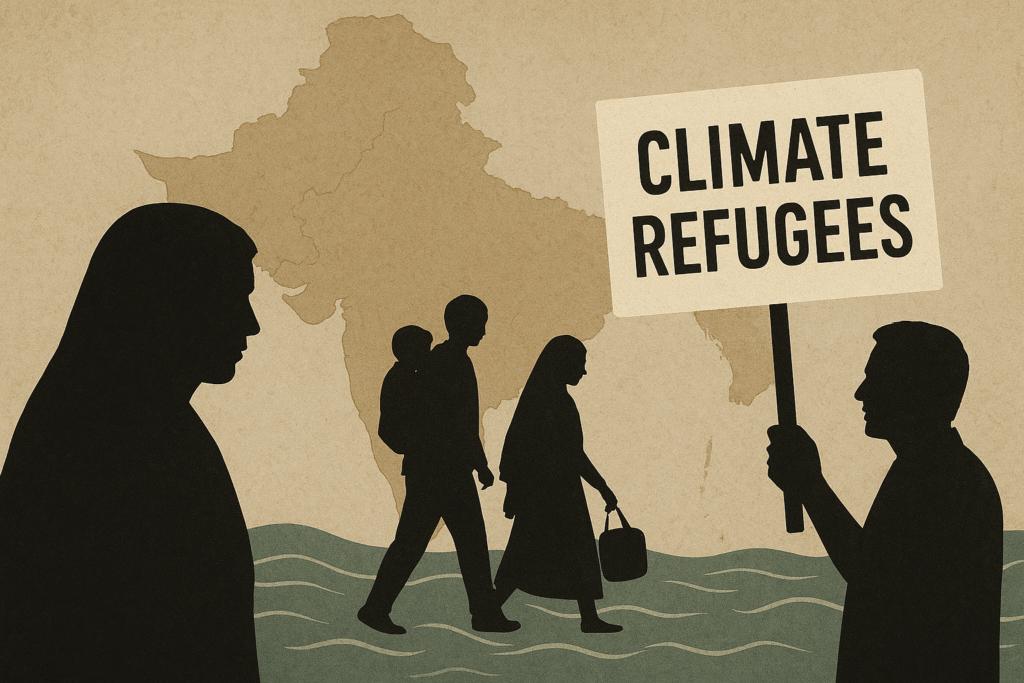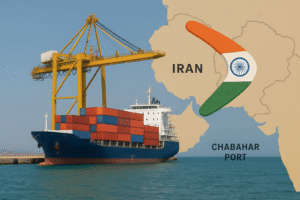Politics of Climate Displacement: Negotiating Climate Refugee Status and their problems across South Asia

The Rising Tide of Climate Displace in south Asia by GSI
Climate induced migration is inevitable in this century for South Asia but we still have the absence of legal recognition of climate refugees, which not only undermines human security but also destabilizes regional socio-political structures. Ignoring the need for a right-based, regional legal framework for solving this problem, could be fatal, as we are already aware that the crisis will be deepened by mid-century.
Climate induced displacement or environmental migration occurs when masses are forced to leave due to natural disasters or long-term climate change impacts. No one can deny that climate change is one of the pressing issues in South Asia, according to the climate risk index as a continent which is home to 25% of the world’s population is most vulnerable to disastrous impacts of climate change. And these catastrophic climatic impacts and climate induced migration could alter South Asia’s socio-economic landscape. Despite this pressing issue, discussion on human security impacts of climate change, the topic of climate induced migration is often viewed as a distant and intangible concept. There was widespread consensus on ‘’loss and damage’’ at COP conferences, yet climate migration in developing countries was barely mentioned, but in reality, we can’t deny the occurrence of it at an unimaginable scale.
The World Bank estimates that by 2050, South Asia will face a crisis of 50 million climate refugees, which will be the result of both short-term natural disasters like floods and cyclones and slow-onset environmental changes such as sea level rise, soil degradation and desertification.
The consequences of climate-induced migration ripple through both sending and receiving areas, where push factors like floods and droughts intersect with pull factors such as livelihood opportunities and perceived safety. There is always been a debate with regard to whether migration is a strategy to adapt to the consequences of climate change or a coping strategy .No matter how we classify it, the truth is that migration caused by climate change is increasing rapidly throughout South Asia, an area where the growing scale and severity of climate-induced displacement create significant social, economic, and political difficulties for the future of the region. Countries in South Asia may vary with climatic experiences but data shows the same trend that climate change is driving mass internal displacement. Due to threats of riverbank erosion and rising sea tides, over 50 million people residing in coastal areas are on brink of having rural-to-urban displacement that will in turn fuel overcrowding and resource conflict in cities. Though having less population, Nepalis expected to see 1.3 million displaced by 2025 due climate induced disasters.
Talking of Pakistan, frequent floods, droughts and storms occurred during the time between 1980 and 2020 had displaced 23.6 million people from 2008-2022 alone. The 2022 floods alone submerged a third of the country, displacing 8 million and caused damages upto 30$ billion. Similarly coastal erosion and cyclones have posed challenges to Indians as data suggests that it may lead to displacement of 45 million people by 2050.
These cases are contextually different but they share the same reality: saying this phenomenon merely an economic choice would be wrong because it is indeed increasingly becoming a survival strategy against ecological breakdown. Beside all these worrisome statistics, the legal framework continues to deny these migrants recognition or protection, leaving the majority of the population in this region at the stake of vulnerability and uncertainty.
More than just shattering the economy of a country, climate induced migration dismantles social fabric as migrants lose their livelihoods, communities crippled, health risks intensify and cultural identities diminish. Erosion of social cohesion and cultural continuity, which is the most devastating impact of migration, is remaining invisible in policy debates. Ignoring these intangible factors is not only shortsightedness but a moral dilemma, which reduces the identity of displaced communities to mere statistics, rather than human beings.
Despite staggering statistics and growing awareness, the ignorance to recognize the climate refugee’s status remains a legal failure. Flood, drought, and sea level rise victims are not covered under the 1951 Refugee Convention, which was enshrined in a Cold War mindset. Millions of people in Bangladesh, Pakistan, and India thus live in a legal void, recognized in words but not protected in reality. There is a global reluctance to modify laws to reflect the reality of climate collapse, as seen by the persistence of antiquated concepts in European frameworks such as Directive 2011/95/EU.
In South Asia, weak legal frameworks along with political neglect could cost states more as we are already the most climate vulnerable nations. India, Bangladesh and Pakistan continue to securitize migration, portraying it as a sovereignty threat rather than human rights crisis. And talking of Global Compact for Migration (2018) offers protection and recognition to migrants only on the whims of national politics. Particularly since South Asia is bearing the consequences of emissions it did not produce, this diversion—concentrating on borders and populist narratives rather than human safety—is a betrayal of both climate justice and human dignity.
Though International human rights law has begun the efforts to tackle this issue, progress is halting. Despite acknowledging violations of cultural and family rights, the UN human rights committee hesitated to affirm the most basic principle which is the right of life. This hesitation exposes the incompatibility of global legal institutions: they are crawling towards the basic recognition step when millions already face existential threats. Such hesitation and reluctance undermines the credibility of human rights in the age of climate crisis
South Asian state governments hide behind emergency relief and temporary efforts which is no longer the case because the protection of climate migrants is becoming a non-negotiable priority. Several South Asian countries have devised different adaptation frameworks such as Pakistan’s National Action Plan (2023), Bangladesh’s Mujib Climate Prosperity Plan, and India’s National Action Plan shows these countries progress toward climate change impacts but these frameworks remain half measures because they lack and overlook certain provisions that ensures the protection and rehabilitation of displaced people, especially women and marginalized groups .Displacement being a long term developmental challenge should not be treated as temporary crisis , a challenge that requires proactive, inclusive and gender sensitive strategies.
At this crucial time, collaboration is not optional at regional level, it is the test of South Asia’s credibility in climatic responsibility. Climate change is not confined in borders, yet we south Asian countries choose to cling to fragmented and nationalistic concepts and responses that are clearly not sufficient as the worrisome climatic conditions demands revisions in such responses. Suggesting revision of SAARC, creation of cross-border climate data systems and negotiation of South Asian climate refugees charter are not merely fancy or ideal demands but are indeed urgent necessities.
If this continued inaction proceeds further fueled by geopolitics and nationalists’ rhetoric, leaving things unnoticed will doom millions to endless uncertainty. Strong regional unity has the capability to transform South Asia from a climate victim into a model of Climate justice and resilience..



